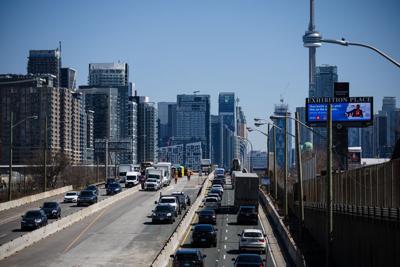The city needs to find nearly $18 billion more over the next decade to keep its aging buildings, roads, parks and city services that depend on its infrastructure from deteriorating further.
That’s an $8-billion decrease from last year’s funding gap, according to a new report heading to Mayor Olivia Chow’s executive committee next week.Â
That’s “$8 billion more toward fixing our city,” Chow said at a media briefing inside city hall on Tuesday. “Whether it’s roads, parks, community centres, libraries, subways, tracks … It’s all been deteriorating and that stops now.”
The city attributes the decrease to it dedicating half of its historic $59.6 billion capital budget to its maintenance needs — and the “new deal” with the province that uploaded the Gardiner and Don Valley Parkway, eliminating the city’s largest repair liability.
The report says five key areas are driving the current capital funding gap: the TTC needs $11 billion, º£½ÇÉçÇø¹ÙÍøCommunity Housing needs $4 billion, roads and bridges need $2 billion and city facilities require $1 billion.
Toronto’s operating budget takes care of the day-to-day expenses needed to run city services. Capital budgets focus on large-scale, long-term investments.
The $26-billion gap reported last year only reflected the funding shortfall for º£½ÇÉçÇø¹ÙÍøassets that aren’t considered essential across certain city divisions such as recreation.Â
The proposed 2025 city budget earmarks a record $32.4 billion to fixing the city’s aging infrastructure over the next 10 years — with $2.9 billion
The proposed 2025 city budget earmarks a record $32.4 billion to fixing the city’s aging infrastructure over the next 10 years — with $2.9 billion
However, Tuesday’s  covers about $215 billion worth of assets that make up the infrastructure, facilities, equipment and everything that both essential and non-essential services need. These are services residents rely on every day such as the transportation network, recreation and community centres, bridges, water systems, health and social services, shelters, emergency services and the like.
“It is not a direct comparison,” said chief financial officer Stephen Conforti. “But the reduction demonstrates progress.”
The new report described the state of most of the city’s infrastructure as being in “fair” condition, meaning it is “performing acceptably but below standard” and is approaching the end of its service life, to “very good” which means it’s new or recently upgraded.
But just to maintain all of the listed assets would require more than $50 billion over 10 years, according to the report.
Earlier this year, city staff presented  at nearly $60 billion mainly to flatten the curve on its rising backlog of needed maintenance. Of that, $32.4 billion is dedicated to the city’s aging infrastructure — the most ever earmarked for state-of-good-repair spending.
“We can’t stop here. Yes, we know there’s TTC slow zones, potholes. We see the ongoing infrastructure … challenges facing us,” Chow said.
About 20 per cent of the infrastructure covered in the report is rated as in poor or very poor condition, meaning it has severely deteriorated and requires upgrades or replacements.
The TTC is looking at full weekend and early access closures with longer time frames in 2025.
The TTC is looking at full weekend and early access closures with longer time frames in 2025.
This does not mean they pose a safety risk, said Conforti. For example, an outdated and “very poor” air conditioning and heating system in a community centre does not pose a direct safety hazard.
º£½ÇÉçÇø¹ÙÍøCommunity Housing is doing slightly worse than last year’s report. About 44 per cent of its assets are rated as poor or worse, a small uptick from last year’s 42 per cent.
Parks and recreation need almost $150 million more a year over the next decade to maintain its state of good repair. More than half of its assets have severely deteriorated.
Toronto’s libraries are in much better shape with 70 per cent of its infrastructure is in a fair or better state.
The city’s paramedic service is in the worst shape out of the municipality’s emergency services with 56 per cent of its assets in poor or worse states.
Few city services have all or nearly all of its assets in completely good condition. They include public health, children’s services, Exhibition Place, solid waste management, and forestry management which maintains the city’s natural areas.
While the Gardiner upload unlocked nearly $2 billion, Chow said Tuesday the cash-strapped city has had to “make tough decisions to say ‘no’ to some nice-to-have projects.”
This included things like a full redevelopment of the St. Lawrence Center for the ArtsÌý²¹²Ô»åÌý³Ù³ó±ðÌýproposed Cummer station which was part of Metrolinx’s extension project for the TTC’s Yonge Line.



































To join the conversation set a first and last name in your user profile.
Sign in or register for free to join the Conversation